SpecheBox Help
Quick Links
- Browser Support: Your browser must support HTML5 and either the Websocket or EventSource API.
Supported browsers, as of April 18, 2016:
Websockets
- Computer Browsers: IE 11, Edge 12+, Firefox 11+, Chrome 16+ Safari 7+, Opera 12.1+
- Mobile Browsers: iOS Safari 6.1+, Android 4.4+, Blackberry 7+, Opera Mobile 12.1+, Chrome for Android 49, Firefox for Android 45, IE Mobile 10+, UC for Android 9.9
EventSource
- Computer Browsers: Firefox 6+, Chrome 6+ Safari 5+, Opera 11.5+
- Mobile Browsers: iOS Safari 4.1+, Android 4.4+, Blackberry 7+, Opera Mobile 12+, Chrome for Android 49, Firefox for Android 45, UC for Android 9.9
-
JavaScript must be enabled in your browser.
-
Data Connections:
-
HTTP and WS connections are requested from text.speche.com:80.
-
HTTPS and WSS connections are requested from text.speche.com:443.
-
Firewall, proxy server, and security device interactions are handled through the client browser. Enter any necessary information into the client browser, to allow connections through your firewall, proxy server, or security device.
-
Connection Problems: Call Speche Support at (877) 838-9080 or e-mail us at support@speche.com.
SpecheBox Display - Your default colors and available features may be different from those shown.
Loading the SpecheBox: A loading message will be offered while making data connections.
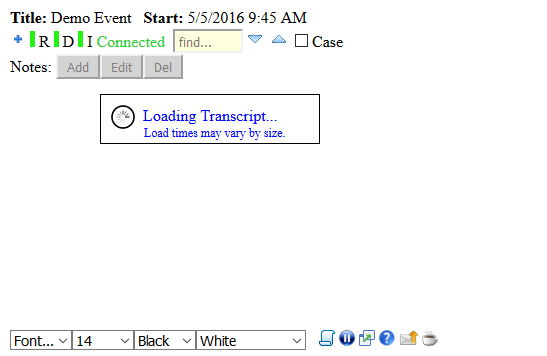
Standard SpecheBox display:

SpecheBox Annotation display:
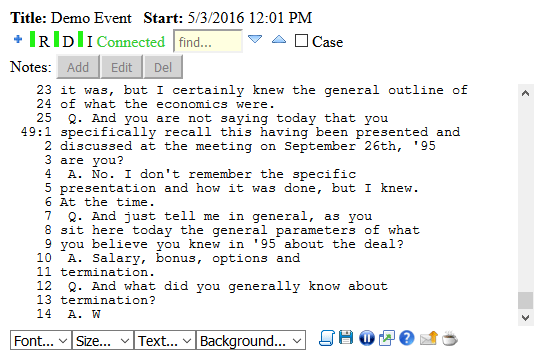
SpecheBox Features - Some SpecheBox features are service or host dependent, and may not be available.
-
Real-time Text Delivery- Receive real-time delivery of a live transcript or captions.
Caption content may be delayed to synchronize it with accompanying audio or video.
-
Complete Transcript- Get all of the content, all of the time.
As the SpecheBox loads, existing content is merged with the live feed.
Missed something?
-
Customizable Display- Customize the SpecheBox display to fit your needs
or your desktop.
-
Change the Font and Font Size to optimize text readability.
See the Font... and Size...
pull-downs for additional information.
-
Change the Text and Background Colors to a preferred color palette or to
minimize eye stress. See the Text... and Background...
pull-downs for additional information.
-
Resize the SpecheBox by resizing your browser window. Embedded SpecheBox users can click on the float icon
 to open the SpecheBox in a resizable window.
to open the SpecheBox in a resizable window.
-
Transcript Save- At any point, save the transcript (and your annotations) as an XMPTF, PTF, HTM, or TXT file. See
Save Transcript
for additional information.
-
Transcript Search- Navigate up or down, through your search results. The match count is updated as you navigate. See the
Search Reference
for additional information.
-
Pause the Action- Need to take a closer look? Pause the text when desired. See
Pause / Resume for additional information.
-
Transcript Snapshot Viewer - Open a complete, up to the minute,
snapshot in a separate browser window. See Transcript Snapshot for
additional information.
-
Status Notifications- Know that status of your event, data source, and event data, upon
loading the SpecheBox. The Repoter, Data, and Idle status indicators are idenpendent of
the Event / Connection status indicator. See the
Status Reference for additional information.
-
Annotations- Add annoations (Marks, Notes, and Issues) to the transcript. Save your annotations as a quick report, or with the transcript. See the
Annotation Reference for additional information.
Status Reference- The status bar may not be available for all events.
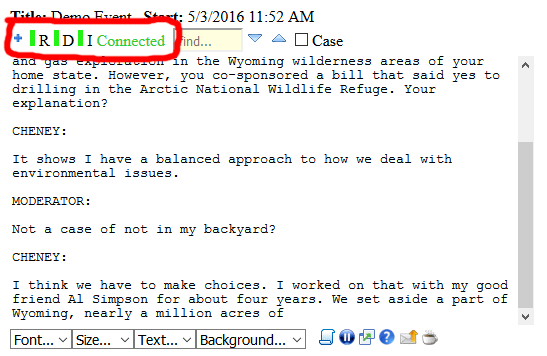
-
Expandable Status Bar
Click on the  icon to expand the Reporter, Data, and Idle status indicators.
icon to expand the Reporter, Data, and Idle status indicators.

Click on the  icon to collapse the the Reporter, Data, and Idle status indicators.
icon to collapse the the Reporter, Data, and Idle status indicators.

- Reporter Status:
- (Green); indicates a reporter connection.
- (Red) indicates no reporter connection
- (Grey) indicates no event or a status retrieval failure.
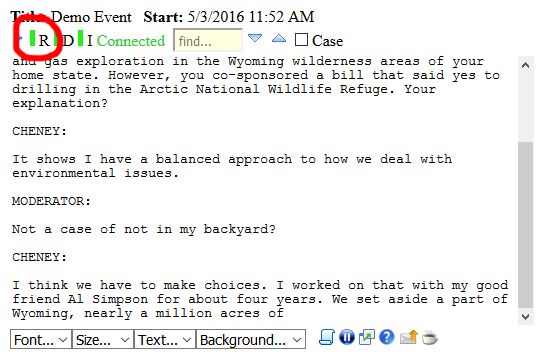
Hover your mouse over the reporter status
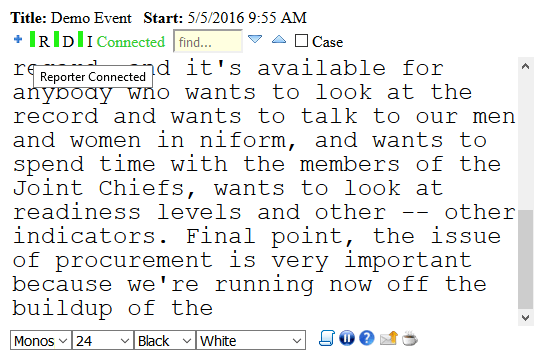
- Data Status:
- (Green) indicates that data has been received within the last 15 minutes.
- (Yellow) indicates that data has been received, but more than 15 minutes ago.
- (Red) indicates that no data has been received.
- (Grey) indicates no event or a status retrieval failure.
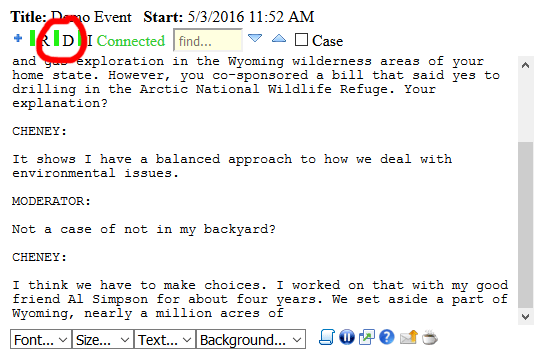
Hover your mouse over the reporter status
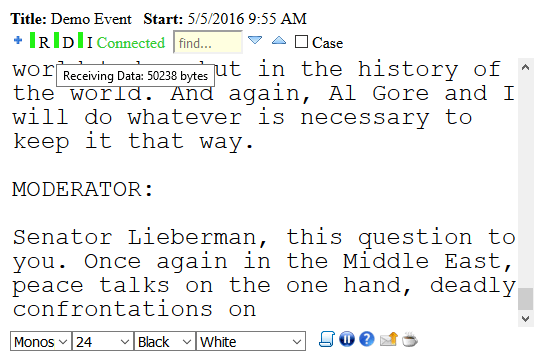
- Idle Status:
- (Green) indicates that data has been received in the last 60 seconds.
- (Yellow) indicates that no data has been received over the last minute.
- (Red) indicates that no data has been received over last five minutes.
- (Grey) indicates no event or a status retrieval failure.
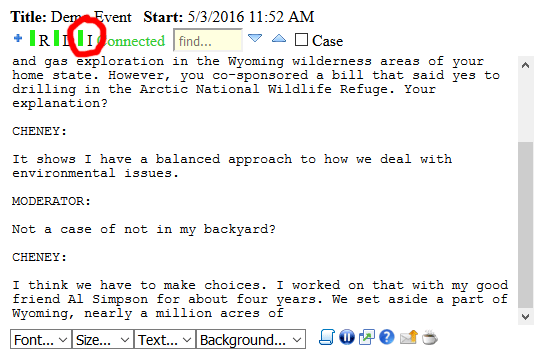
Hover your mouse over the reporter status
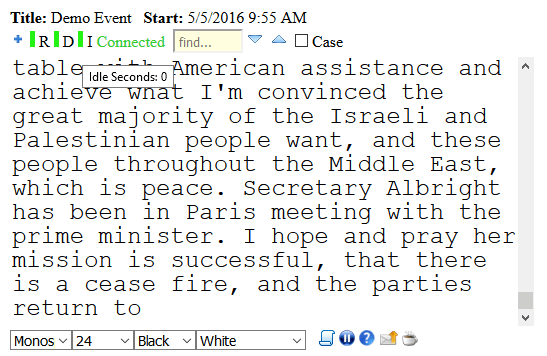
-
Event Status - The event status is a two stage process, verified independently against our incoming (caption) servers and outgoing (broadcast) servers.
- Connecting...- Initial status while the SpecheBox is connecting.
- Checking Archive- Status when starting the archive check.
- No Event- The SpecheBox could not find the event (both status sources).
- Connected- The SpecheBox is connected to the event.
- Event Ending- The event is ending (server notification).
- Event Ended- The event is over.
- Archive- The event has been archived.
- Re-Connect- (clickable) Indicates a connection failure or a disagreement between the data sources. Click on Re-Connect to initiate a manual reconnection.
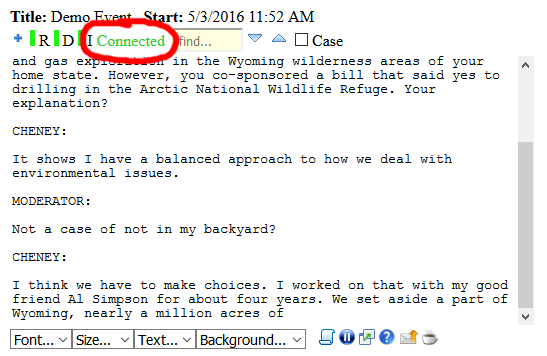
Search Reference- The search bar may not be available for all events.
-
To set a starting point for your search:
-
Click anywhere within the transcript, to search from that point.
-
Unless changed, downward searches begin at the top of the transcript.
-
Unless changed, upward searches begin at the bottom of the transcript.
-
To add or change the Search Text:
-
Type the search text into the (find...) textbox.
-
Double-click on a word within the transcript.
-
Highlight text with the transcript.
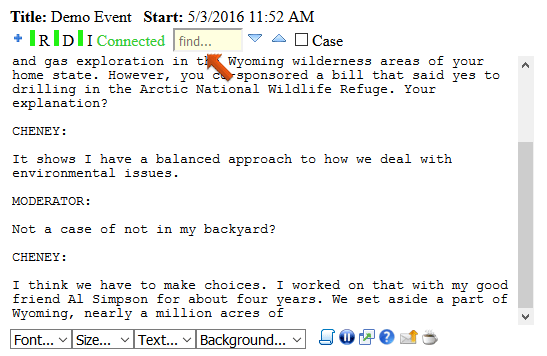
-
To start searching:
-
Press the Enter key, while your cursor is in the textbox.
-
Click on Next (down) icon
 .
.
-
Click on Previous (up) icon
 .
.
The SpecheBox will pause the display and navigate to the first occurrence.
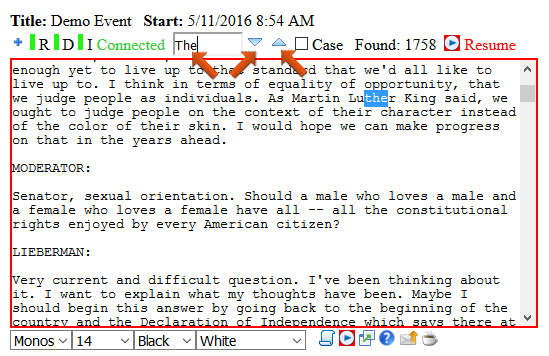
-
Understanding the search results:
-
The SpecheBox will display the number of occurrences found in the transcript.
-
While the SpecheBox is paused, new content will continue to be added to the transcript.
-
As you navigate through the search results, the number of occurrences found may increase over time.
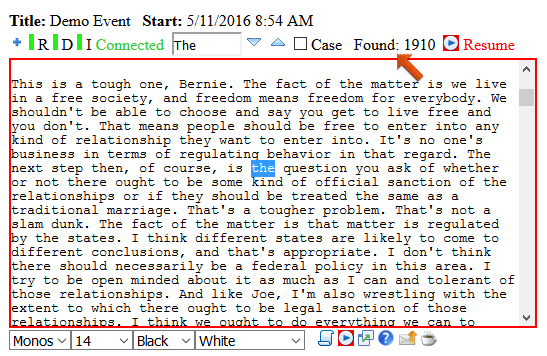
-
Navigate to the next occurrence (down):
-
Click on the Next (down) icon
 .
.
-
Press the Enter key, while your cursor is in textbox. Internet Explorer and Edge users must use the Next icon.
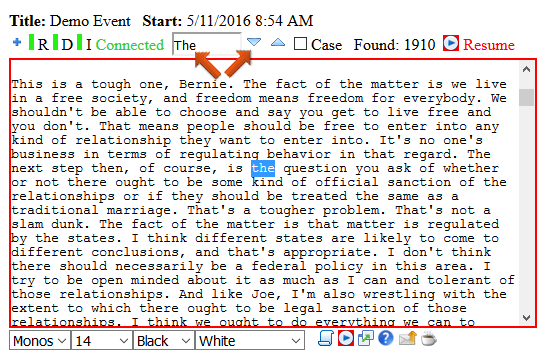
-
Navigate to the previous occurrence (up):
-
Click on the Previous (up) icon
 .
.
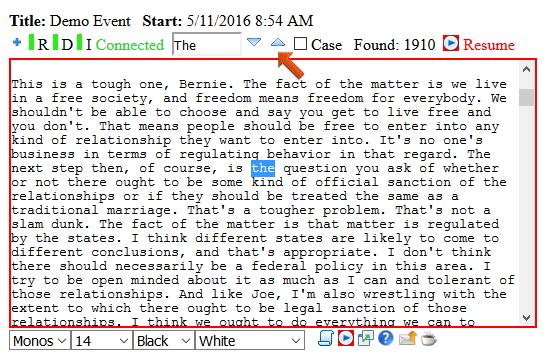
-
Use case matching:
-
Check the Case checkbox to match case while searching.
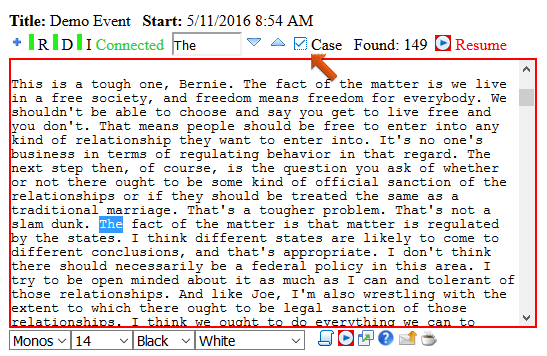
-
Using search with annotation tools:
-
As the search results are navigated, each occurrence will be selected and set as the active line.
-
Navigating to a line containing a note or issue will trigger the Notes: Edit and Del(ete) buttons.
-
Navigating to a line without a note or issue will trigger the Notes: Add button.
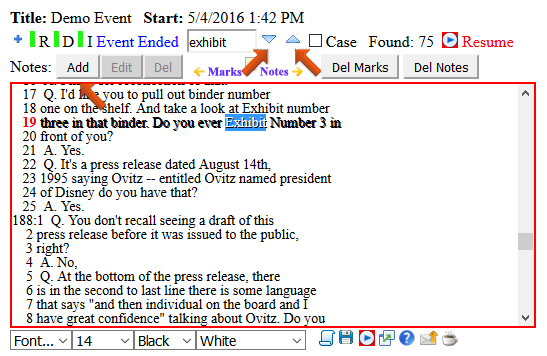
-
Stopping the search:
-
Click on either of the Resume icons
 (or the word Resume in the search bar).
(or the word Resume in the search bar).
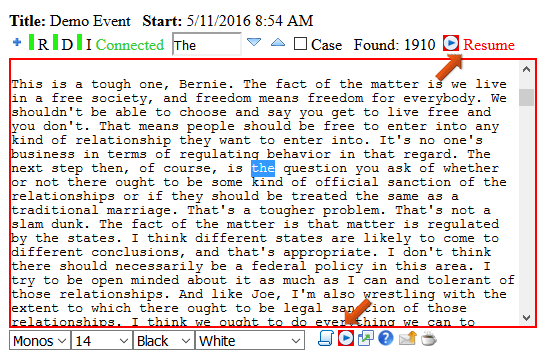
Annotation Reference- Annotations are only available with our legal display.
- Marks:
- Notes and Issues:
- Annotation Navigation:
- Saving Annotations:
-
Add a Mark
-
To mark a line, click on the (page:) line number, for that line.
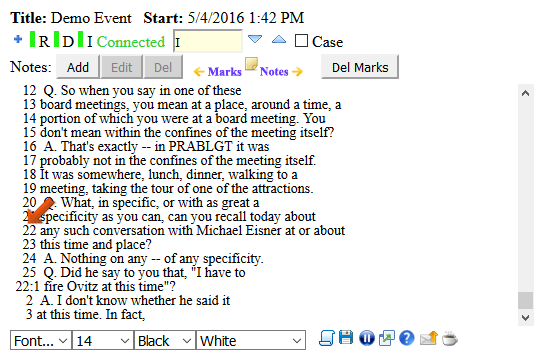
-
The marked line is identified by the yellow background of the (page:) line number.
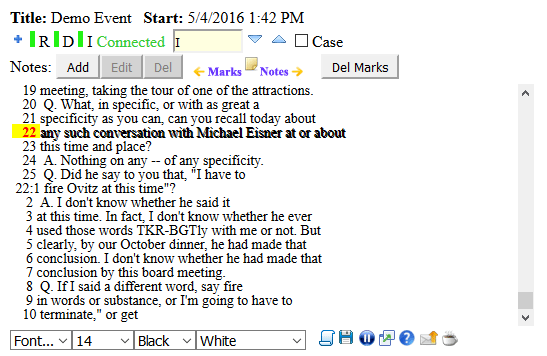
-
Delete a Mark
-
To delete a mark, click on the (page:) line number of the marked line.
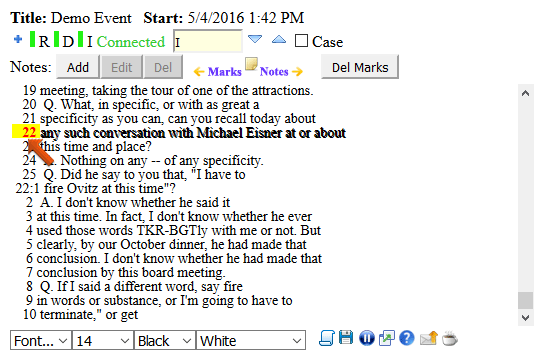
-
Delete all Marks
-
To delete all marks from the transcript, click on the Del Marks button.
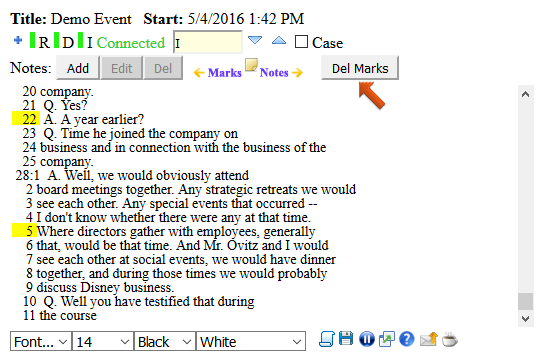
-
You must confirm your intention to delete all marks from the transcript.
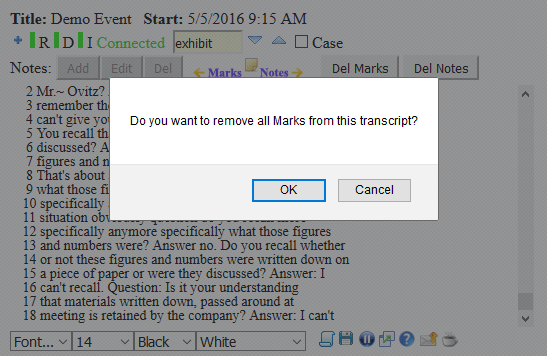
-
Add a Note
- Select the location to add your Note.
- Select a line using the Search tool.
-
Or click on a line in the transcript.
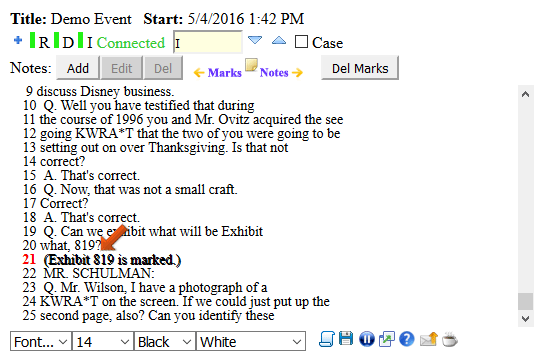
-
Or select transcript text with your mouse.
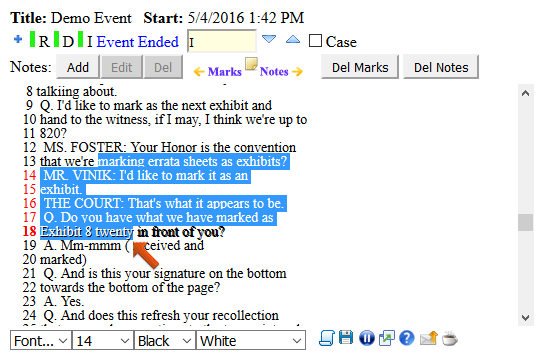
-
Click on the Notes: Add button to open the Annotations window.
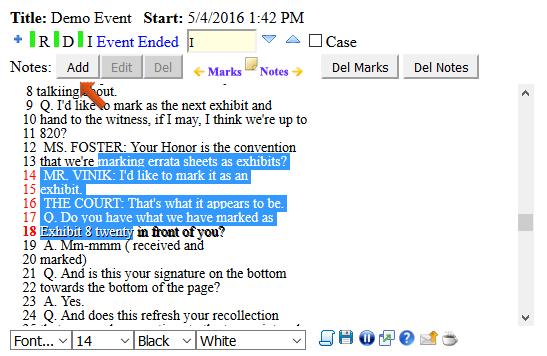
-
Note will be selected, by default. You can select (or rename) an Issue, if desired.
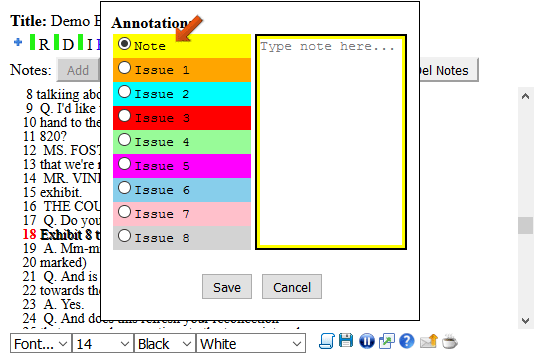
-
Enter your note in right panel.
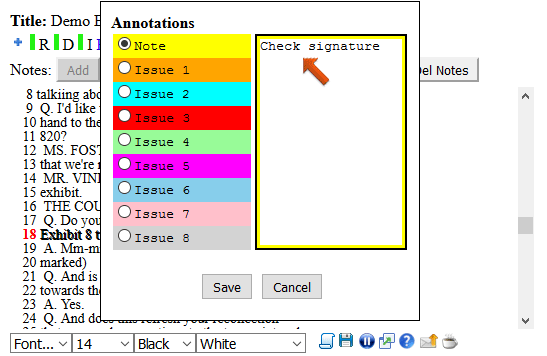
-
Save (or Cancel) your note.
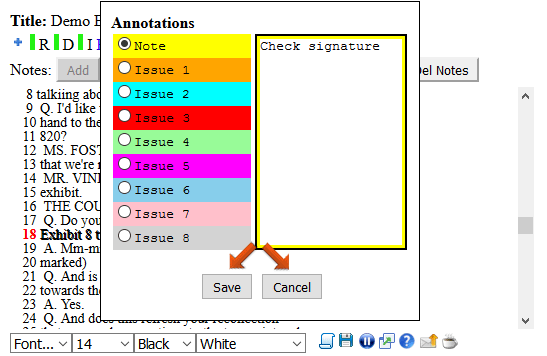
-
Your note will be highlighted in yellow.
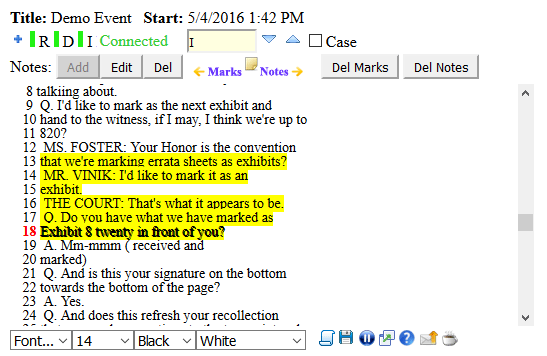
-
Hover your mouse over the highlighted text to see the inner note.
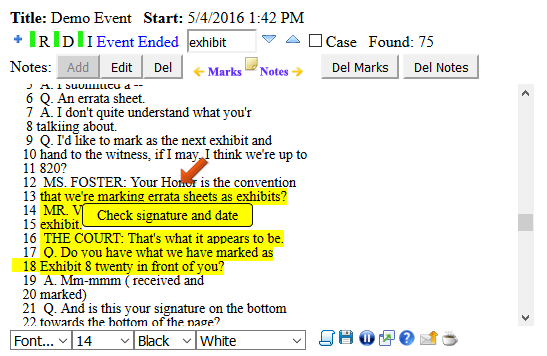
-
Add an Issue
- Select the location to add your issue.
- Select a line using the Search tool.
-
Or click on a line in the transcript.

-
Or select transcript text with your mouse.

-
Click on the Notes: Add button to open the Annotations window.

- Create the issue.
- Select (or rename) an Issue. Note is selected by default.
- Enter your note in the right panal.
- Save (or Cancel) your issue.
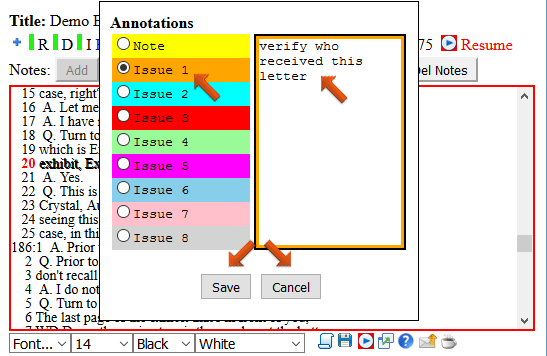
-
Your issue will be highlighted in the color of the selected Issue.
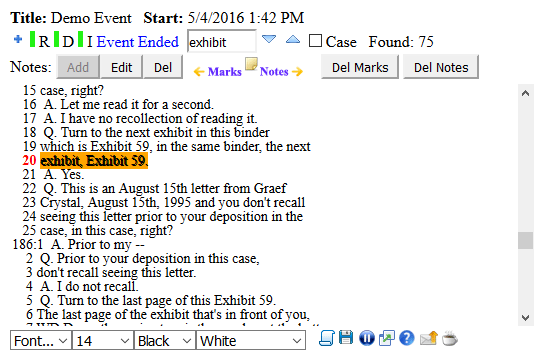
-
Hover your mouse over the highlighted text to see the inner note.
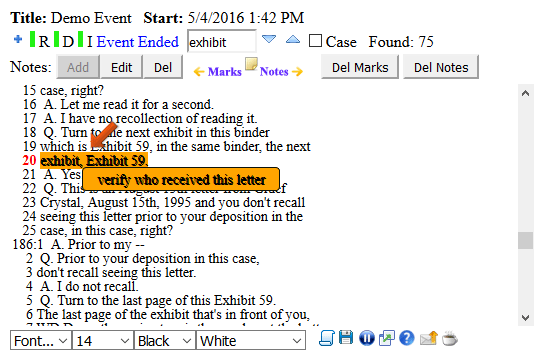
-
Rename an Issue
-
Double-click on the Issue to be renamed (anywhere within the colored background).
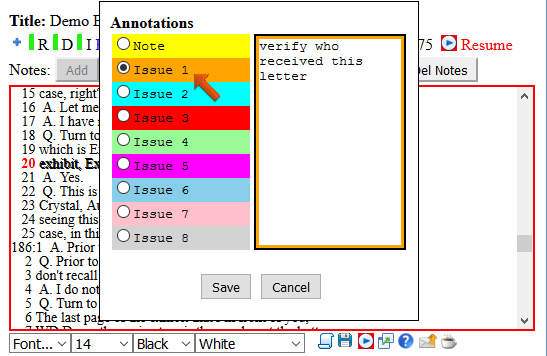
-
Enter the new Issue name and click Save (or Cancel).

-
Continue to add or edit your issue.
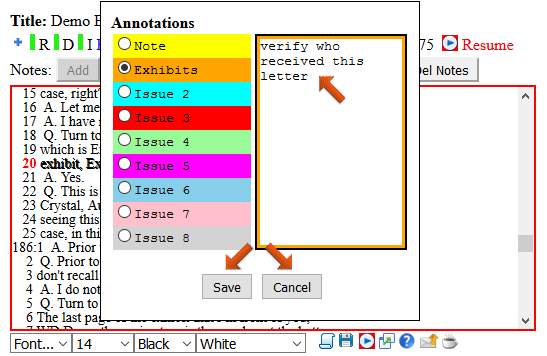
-
Edit a Note or Issue
-
Select a note or issue.
-
Click within a note or issue.
-
Select transcript text within (or overlapping with) a note or issue.
-
Navigate up or down to a note or issue.

-
Click on the Notes: Edit button to open the Annotations window.
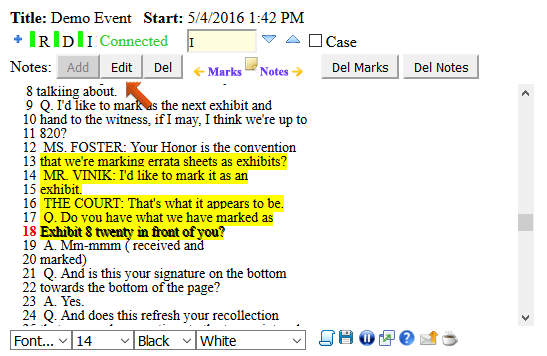
- Update the note or issue.
- Peform any desired edits.
- Change the note or issue selection.
- Rename an Issue
- Edit the note text, in the right panel.
- Save (or Cancel) your changes.

-
Enter your note in right panel.

-
Save (or Cancel) your note.

-
Your note will be highlighted in yellow.

-
Hover your mouse over the highlighted text to see the inner note.

-
Delete a Note or Issue
-
Select a note or issue.
-
Click within a note or issue.
-
Select transcript text within (or overlapping with) a note or issue.
-
Navigate up or down to a note or issue.

-
Click on the Notes: Del button to delete the note or issue.
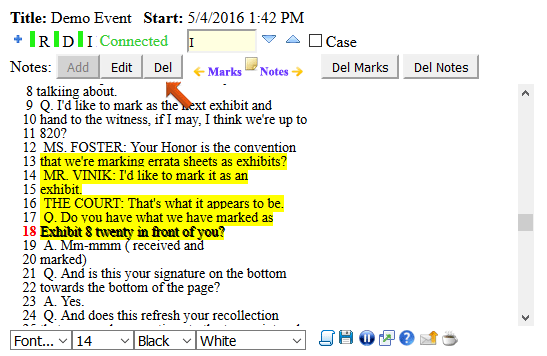
-
Delete all Notes and Issues
-
To delete all notes and issues from the transcript, click on the Del Notes button.
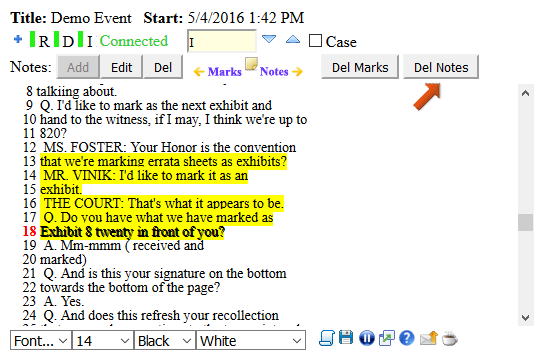
-
You must confirm your intention to delete all notes and issues from the transcript.
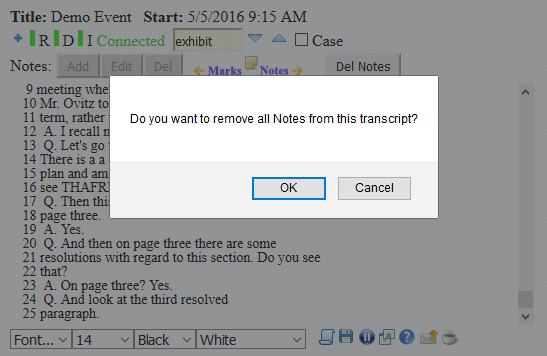
-
Next Annotation (Down)
-
Downward navigation is from the top of the transcript, or the currently active line (last click).
-
Click on

 to navigate to the next mark, note, or issue.
to navigate to the next mark, note, or issue.
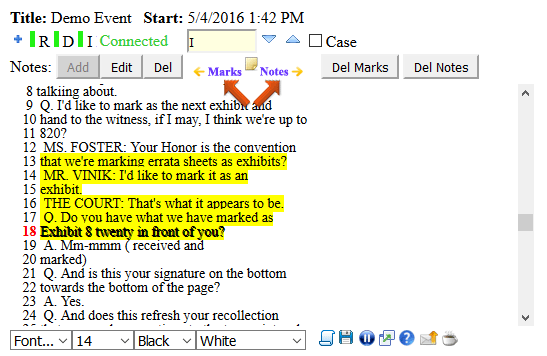
-
Previous Annotation (Up)
-
Upward navigation is from the bottom of the transcript, or the currently active line (last click).
-
Click on

 to navigate to the previous mark, note, or issue.
to navigate to the previous mark, note, or issue.

-
Save Annoations
-
Click on either the Save icon
 (bottom) or Annotations icon
(bottom) or Annotations icon  (top) to open the Save window.
(top) to open the Save window.
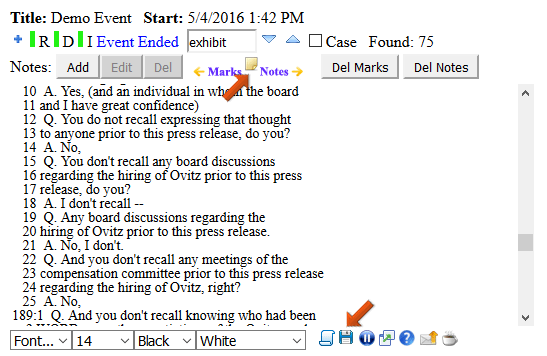
- Save the annoations to a file.
- Select a file type:
- Annotations Quick Report - Save all annotations with the selected transcript content and line numbers.
- TextMap® XMPTF Transcript Snapshot** - Save an XMPTF transcript containing the annotations.
- LiveNote® PTF Transcript Snapshot** - Save a PTF transcript containing the annotations.
** With Annotations.
- Enter the name of the file in the File Name textbox.
-
(Optional) Select a Character Encoding:
- ASCII / ANSI (default) is the recommended Encoding for all English language transcripts.
- Some Lit. Support software require ASCII / ANSI encoding to import PTF and XMPTF files.
- (Location Dependent) Your default encoding may be expanded to include all Latin characters sets.
- UTF-8 is the recommended Encoding for non-Latin character sets.
- Some Lit. Support software can import UTF-8 text (.txt) files.
- Use UTF-8 if non-English Latin (accented) characters are not supported by your default encoding.
- Click on the Save button to send the save request to your browser.
- Use your browser's Save dialog to save (and open) the file.
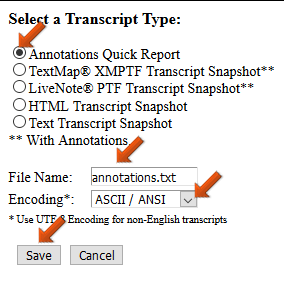
Toolbar Reference- Toolbar options are offered at the discretion of the event host. Some of the options below may not be available for your event.
-
Font... - Change the Font
-
Size... - Change the Font Size
-
Text... - Change the Text Color
-
Background... - Change the Background Color
-
White-space - Expand or collapse white-space
-
Transcript - View a snapshot of the complete transcript
-
Save - Save the accumulated transcript and / or annotations
-
Pause / Resume - Pause or Resume automatic scrolling in the SpecheBox transcript display.
-
Float - Open the SpecheBox in resizable browser window
-
Help - Open this help file in a browser window
-
Feedback - Send feedback or report a problem.
-
SpecheBox Java Applet - Switch to the SpecheBox Java Applet
-
Chat - Open a chat window
-
Font... Pull-down
-
Click on the Font... pull-down to change the Font.
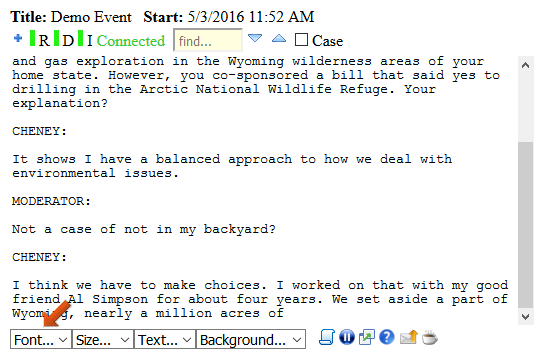
-
Select your desired Font.

-
Size... Pull-down
-
Click on the Size... pull-down to change the Text Size.
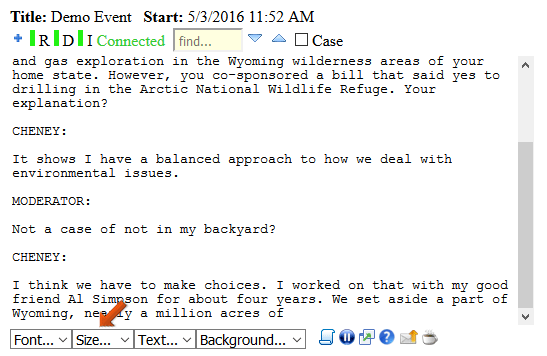
-
Select your desired Background Color.

-
Text... Pull-down
-
Click on Text... pull-down to change the Text Color.
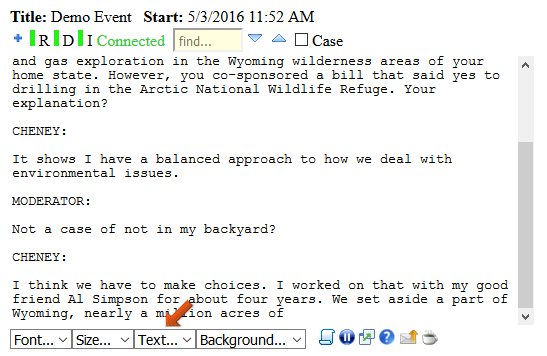
-
Select your desired Text Color.

-
Background... Pull-down
-
Click on the Background... pull-down to change the Background Color.

-
Select your desired Background Color.
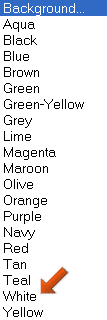
-
White-space Control: Expand
 / Collapse
/ Collapse 
-
Click on the Expand white-space icon to expand the (currently collapsed) white-space within the transcript.
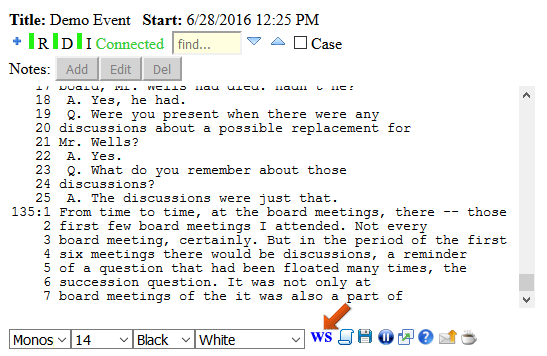
-
Click on the Collapse white-space icon to collapse the (currently expanded) white-space within the transcript.
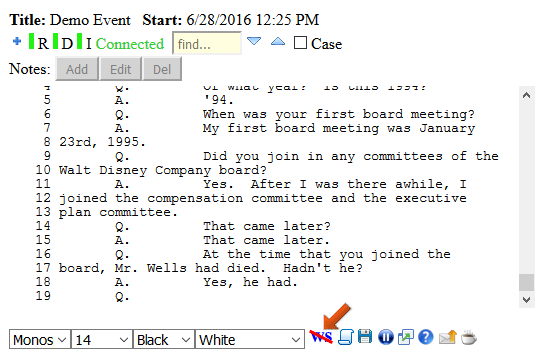
-
Transcript Snapshot

Click on the Transcript Snapshot icon to open a complete, up to the
minute, snapshot of the transcript in a new browser window.
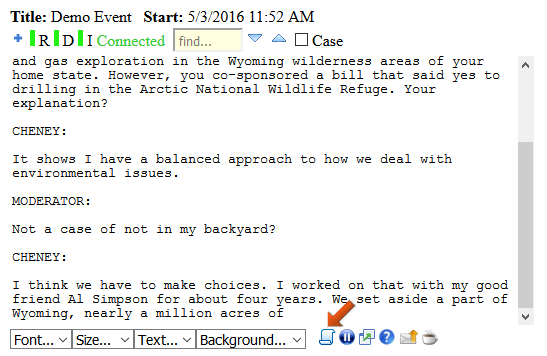
-
Save Transcript (and / or Annoations)

- Click on the Save icon to open the Save window.
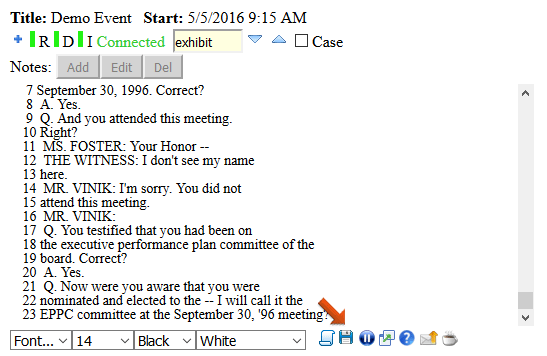
- Save the transcript to a file.
- Select a file type:
- TextMap® XMPTF Transcript Snapshot - Save the transcript as an XMPTF formatted file (.xmptf).
- LiveNote® PTF Transcript Snapshot - Save the transcript as a PTF formatted file (.ptf).
- HTML Transcript Snapshot - Save the transcript as a HTML formatted file (.htm).
- Text Transcript Snapshot - Save the transcript as a Text file (.txt).
- Enter the name of the file in the File Name textbox.
-
(Optional) Select a Character Encoding:
-
ASCII / ANSI (default) is the recommended Encoding for all English language transcripts.
- Some Lit. Support software require ASCII / ANSI encoding to import PTF and XMPTF files.
- (Location Dependent) Your default encoding may be expanded to include all Latin characters sets.
-
UTF-8 is the recommended Encoding for non-Latin character sets.
- Some Lit. Support software can import UTF-8 text (.txt) files.
- Use UTF-8 if non-English Latin (accented) characters are not supported by your default encoding.
- Click on the Save button to start your browser's Save dialog.
- Use your browser's Save dialog to save (or open) the file.
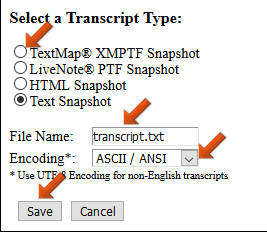
-
Pause
 / Resume
/ Resume 
- Click on the Pause icon (or scroll up) to pause automatic scrolling.
While paused:
- New text will continue to be added to the transcript.
- The Pause icon will change to the Resume icon.
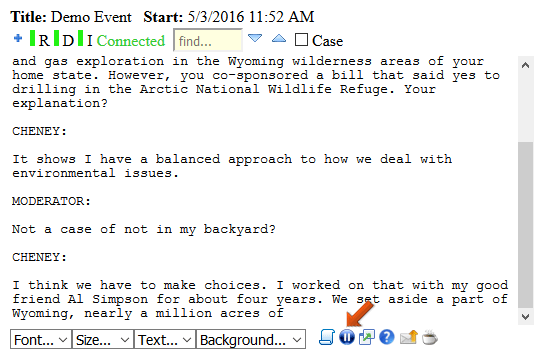
-
Click on the Resume icon (or scroll to the bottom) to resume automatic scrolling.
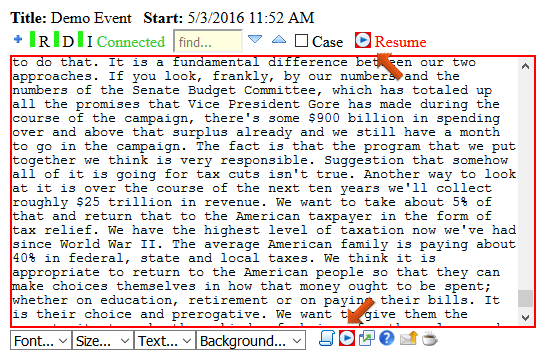
-
Float the SpecheBox

Click on the Float icon to open the SpecheBox in a resizable browser window.
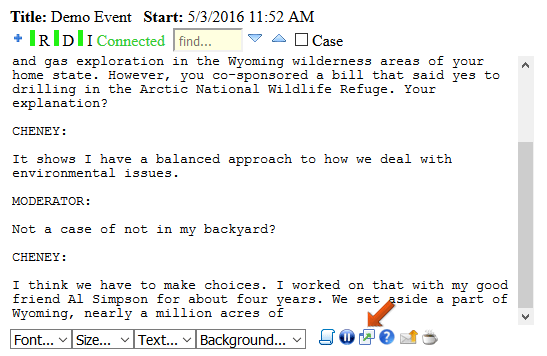
-
Help

Click on the Help icon to open this document in a new browser window.
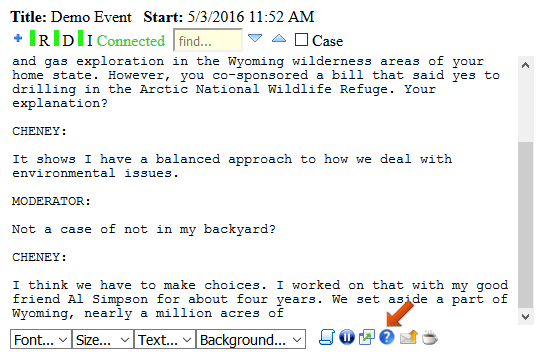
-
Send Feedback

- Click on the Feedback icon to open the Feedback form.
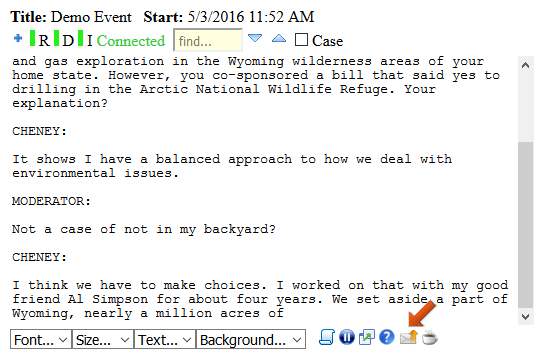
-
Complete the Feedback form.
- To receive a reply, enter your e-mail address.
- Enter your feedback or describe the problem you are experiencing.
- Click on the Submit button to send your feedback.
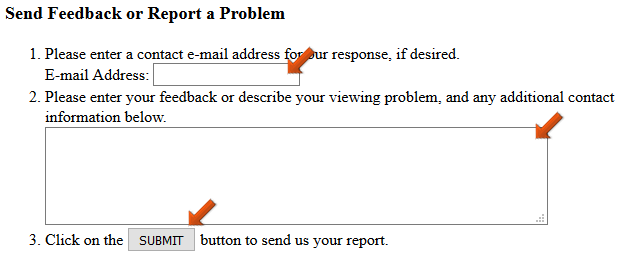
-
SpecheBox Applet

Click on the Java icon to open the SpecheBox Applet in the same browser window.
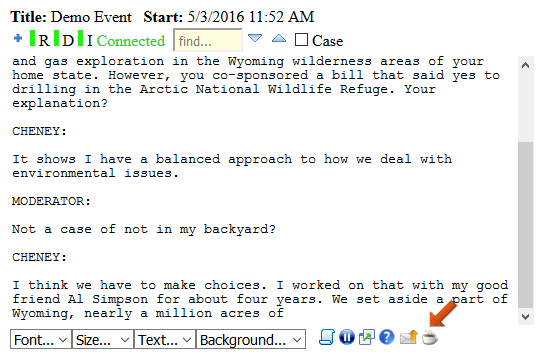
-
Chat

Click on the Chat icon to open chat in a new browser window.
- Some browsers may open the chat in a new tab.
- Drag the new tab out of the current browser window.
- The tab will be opened in a new browser window
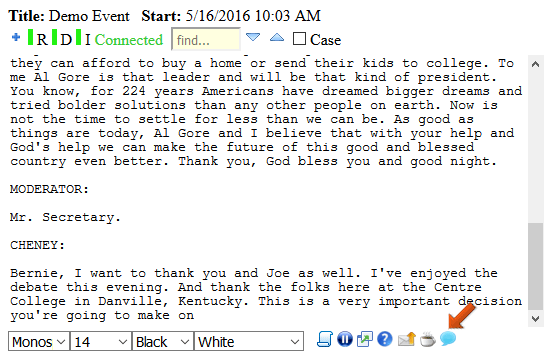
 to open the SpecheBox in a resizable window.
to open the SpecheBox in a resizable window.




 icon to expand the Reporter, Data, and Idle status indicators.
icon to expand the Reporter, Data, and Idle status indicators.
 icon to collapse the the Reporter, Data, and Idle status indicators.
icon to collapse the the Reporter, Data, and Idle status indicators.







 .
.
 .
.






 (or the word Resume in the search bar).
(or the word Resume in the search bar).


























 to navigate to the next mark, note, or issue.
to navigate to the next mark, note, or issue.


 to navigate to the previous mark, note, or issue.
to navigate to the previous mark, note, or issue.
 (bottom) or Annotations icon
(bottom) or Annotations icon  (top) to open the Save window.
(top) to open the Save window.










 / Collapse
/ Collapse 






 / Resume
/ Resume 










